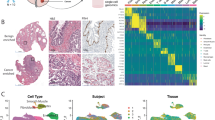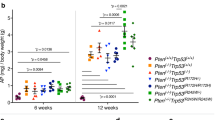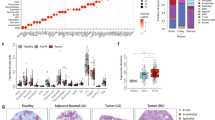Abstract
Human tumors are heterogeneous and evolve through a dynamic process of genetic mutation and selection. During this process, the effects of a specific mutation on the incipient cancer cell may dictate the nature of subsequent mutations that can be tolerated or selected for, affecting the rate at which subsequent mutations occur. Here we have used a new mouse model of prostate cancer that recapitulates several salient features of the human disease to examine the relative rates in which the remaining wild-type alleles of Pten and p53 tumor suppressor genes are lost. In this model, focal overexpression of c-MYC in a few prostate luminal epithelial cells provokes a mild proliferative response. In the context of compound Pten/p53 heterozygosity, c-MYC-initiated cells progress to prostatic intraepithelial neoplasia (mPIN) and adenocarcinoma lesions with marked heterogeneity within the same prostate glands. Using laser capture microdissection and gene copy number analyses, we found that the frequency of Pten loss was significantly higher than that of p53 loss in mPIN but not invasive carcinoma lesions. c-MYC overexpression, unlike Pten loss, did not activate the p53 pathway in transgenic mouse prostate cells, explaining the lack of selective pressure to lose p53 in the c-MYC-overexpressing cells. This model of heterogeneous prostate cancer based on alterations in genes relevant to the human disease may be useful for understanding pathogenesis of the disease and testing new therapeutic agents.
This is a preview of subscription content, access via your institution
Access options
Subscribe to this journal
Receive 50 print issues and online access
$259.00 per year
only $5.18 per issue
Buy this article
- Purchase on SpringerLink
- Instant access to full article PDF
Prices may be subject to local taxes which are calculated during checkout








Similar content being viewed by others
Abbreviations
- PIN:
-
prostatic intraepithelial neoplasia
- LCM:
-
laser-captured microdissection
- BHQ:
-
black hole quencher
References
Abdulkadir SA, Carbone JM, Naughton CK, Humphrey PA, Catalona WJ, Milbrandt J . (2001a). Frequent and early loss of the EGR1 corepressor NAB2 in human prostate carcinoma. Hum Pathol 32: 935–939.
Abdulkadir SA, Qu Z, Garabedian E, Song SK, Peters TJ, Svaren J et al. (2001b). Impaired prostate tumorigenesis in Egr1-deficient mice. Nat Med 7: 101–107.
Andreoiu M, Cheng L . (2010). Multifocal prostate cancer: biologic, prognostic, and therapeutic implications. Hum Pathol 41: 781–793.
Bookstein R, MacGrogan D, Hilsenbeck SG, Sharkey F, Allred DC . (1993). p53 is mutated in a subset of advanced-stage prostate cancers. Cancer Res 53: 3369–3373.
Brooks JD, Bova GS, Ewing CM, Piantadosi S, Carter BS, Robinson JC et al. (1996). An uncertain role for p53 gene alterations in human prostate cancers. Cancer Res 56: 3814–3822.
Carver BS, Tran J, Gopalan A, Chen Z, Shaikh S, Carracedo A et al. (2009). Aberrant ERG expression cooperates with loss of PTEN to promote cancer progression in the prostate. Nat Genet 41: 619–624.
Chen Z, Trotman LC, Shaffer D, Lin HK, Dotan ZA, Niki M et al. (2005). Crucial role of p53-dependent cellular senescence in suppression of Pten-deficient tumorigenesis. Nature 436: 725–730.
Cheng L, Song SY, Pretlow TG, Abdul-Karim FW, Kung HJ, Dawson DV et al. (1998). Evidence of independent origin of multiple tumors from patients with prostate cancer. J Natl Cancer Inst 90: 233–237.
Cheung TH, Lo KW, Yim SF, Chan LK, Heung MS, Chan CS et al. (2004). Epigenetic and genetic alternation of PTEN in cervical neoplasm. Gynecol Oncol 93: 621–627.
Chi SG, deVere White RW, Meyers FJ, Siders DB, Lee F, Gumerlock PH . (1994). p53 in prostate cancer: frequent expressed transition mutations. J Natl Cancer Inst 86: 926–933.
Dinjens WN, van der Weiden MM, Schroeder FH, Bosman FT, Trapman J . (1994). Frequency and characterization of p53 mutations in primary and metastatic human prostate cancer. Int J Cancer 56: 630–633.
Dong JT, Li CL, Sipe TW, Frierson Jr HF . (2001). Mutations of PTEN/MMAC1 in primary prostate cancers from Chinese patients. Clin Cancer Res 7: 304–308.
Effert PJ, McCoy RH, Walther PJ, Liu ET . (1993). p53 gene alterations in human prostate carcinoma. J Urol 150: 257–261.
Ellwood-Yen K, Graeber TG, Wongvipat J, Iruela-Arispe ML, Zhang J, Matusik R et al. (2003). Myc-driven murine prostate cancer shares molecular features with human prostate tumors. Cancer Cell 4: 223–238.
Fearon ER, Vogelstein B . (1990). A genetic model for colorectal tumorigenesis. Cell 61: 759–767.
Feilotter HE, Nagai MA, Boag AH, Eng C, Mulligan LM . (1998). Analysis of PTEN and the 10q23 region in primary prostate carcinomas. Oncogene 16: 1743–1748.
Fenic I, Franke F, Failing K, Steger K, Woenckhaus J . (2004). Expression of PTEN in malignant and non-malignant human prostate tissues: comparison with p27 protein expression. J Pathol 203: 559–566.
Fernandez-Marcos PJ, Abu-Baker S, Joshi J, Galvez A, Castilla EA, Canamero M et al. (2009). Simultaneous inactivation of Par-4 and PTEN in vivo leads to synergistic NF-kappaB activation and invasive prostate carcinoma. Proc Natl Acad Sci USA 106: 12962–12967.
Greene DR, Wheeler TM, Egawa S, Weaver RP, Scardino PT . (1991). Relationship between clinical stage and histological zone of origin in early prostate cancer: morphometric analysis. Br J Urol 68: 499–509.
Grizzle WE, Myers RB, Arnold MM, Srivastava S . (1994). Evaluation of biomarkers in breast and prostate cancer. J Cell Biochem Suppl 19: 259–266.
Groszer M, Erickson R, Scripture-Adams DD, Lesche R, Trumpp A, Zack JA et al. (2001). Negative regulation of neural stem/progenitor cell proliferation by the Pten tumor suppressor gene in vivo. Science 294: 2186–2189.
Gurel B, Iwata T, Koh CM, Jenkins RB, Lan F, Van Dang C et al. (2008). Nuclear MYC protein overexpression is an early alteration in human prostate carcinogenesis. Mod Pathol 21: 1156–1167.
Han B, Mehra R, Lonigro RJ, Wang L, Suleman K, Menon A et al. (2009). Fluorescence in situ hybridization study shows association of PTEN deletion with ERG rearrangement during prostate cancer progression. Mod Pathol 22: 1083–1093.
Iwata T, Schultz D, Hicks J, Hubbard GK, Mutton LN, Lotan TL et al. (2010). MYC overexpression induces prostatic intraepithelial neoplasia and loss of Nkx3.1 in mouse luminal epithelial cells. PLoS One 5: e9427.
Jonkers J, Meuwissen R, van der Gulden H, Peterse H, van der Valk M, Berns A . (2001). Synergistic tumor suppressor activity of BRCA2 and p53 in a conditional mouse model for breast cancer. Nat Genet 29: 418–425.
Kim J, Eltoum IE, Roh M, Wang J, Abdulkadir SA . (2009). Interactions between cells with distinct mutations in c-MYC and Pten in prostate cancer. PLoS Genet 5: e1000542.
Konishi N, Hiasa Y, Hayashi I, Matsuda H, Tsuzuki T, Ming T et al. (1995). p53 mutations occur in clinical, but not latent, human prostate carcinoma. Jpn J Cancer Res 86: 57–63.
McCall P, Witton CJ, Grimsley S, Nielsen KV, Edwards J . (2008). Is PTEN loss associated with clinical outcome measures in human prostate cancer? Br J Cancer 99: 1296–1301.
McMenamin ME, Soung P, Perera S, Kaplan I, Loda M, Sellers WR . (1999). Loss of PTEN expression in paraffin-embedded primary prostate cancer correlates with high Gleason score and advanced stage. Cancer Res 59: 4291–4296.
Mellon K, Thompson S, Charlton RG, Marsh C, Robinson M, Lane DP et al. (1992). p53, c-erbB-2 and the epidermal growth factor receptor in the benign and malignant prostate. J Urol 147: 496–499.
Mentor-Marcel R, Lamartiniere CA, Eltoum IE, Greenberg NM, Elgavish A . (2001). Genistein in the diet reduces the incidence of poorly differentiated prostatic adenocarcinoma in transgenic mice (TRAMP). Cancer Res 61: 6777–6782.
Mirchandani D, Zheng J, Miller GJ, Ghosh AK, Shibata DK, Cote RJ et al. (1995). Heterogeneity in intratumor distribution of p53 mutations in human prostate cancer. Am J Pathol 147: 92–101.
Navone NM, Troncoso P, Pisters LL, Goodrow TL, Palmer JL, Nichols WW et al. (1993). p53 protein accumulation and gene mutation in the progression of human prostate carcinoma. J Natl Cancer Inst 85: 1657–1669.
Nesslinger NJ, Shi XB, deVere White RW . (2003). Androgen-independent growth of LNCaP prostate cancer cells is mediated by gain-of-function mutant p53. Cancer Res 63: 2228–2233.
Preacher KJ . (2001). Calculation for the chi-square test: an interactive calculation tool for chi-square tests for goodness of fit and independence (http://quantpsy.org).
Qian J, Hirasawa K, Bostwick DG, Bergstralh EJ, Slezak JM, Anderl KL et al. (2002). Loss of p53 and c-myc overrepresentation in stage T(2-3)N(1-3)M(0) prostate cancer are potential markers for cancer progression. Mod Pathol 15: 35–44.
Roh M, Kim J, Song C, Wills M, Abdulkadir SA . (2006). Transgenic mice for Cre-inducible overexpression of the oncogenes c-MYC and Pim-1 in multiple tissues. Genesis 44: 447–453.
Sansal I, Sellers WR . (2004). The biology and clinical relevance of the PTEN tumor suppressor pathway. J Clin Oncol 22: 2954–2963.
Schmitz M, Grignard G, Margue C, Dippel W, Capesius C, Mossong J et al. (2007). Complete loss of PTEN expression as a possible early prognostic marker for prostate cancer metastasis. Int J Cancer 120: 1284–1292.
Sircar K, Yoshimoto M, Monzon FA, Koumakpayi IH, Katz RL, Khanna A et al. (2009). PTEN genomic deletion is associated with p-Akt and AR signalling in poorer outcome, hormone refractory prostate cancer. J Pathol 218: 505–513.
Slaughter DP, Southwick HW, Smejkal W . (1953). Field cancerization in oral stratified squamous epithelium; clinical implications of multicentric origin. Cancer 6: 963–968.
Suzuki H, Freije D, Nusskern DR, Okami K, Cairns P, Sidransky D et al. (1998). Interfocal heterogeneity of PTEN/MMAC1 gene alterations in multiple metastatic prostate cancer tissues. Cancer Res 58: 204–209.
Taylor BS, Schultz N, Hieronymus H, Gopalan A, Xiao Y, Carver BS et al. (2010). Integrative genomic profiling of human prostate cancer. Cancer Cell 18: 11–22.
Villers A, McNeal JE, Freiha FS, Stamey TA . (1992). Multiple cancers in the prostate. Morphologic features of clinically recognized versus incidental tumors. Cancer 70: 2313–2318.
Voeller HJ, Sugars LY, Pretlow T, Gelmann EP . (1994). p53 oncogene mutations in human prostate cancer specimens. J Urol 151: 492–495.
Wang L, Wang WL, Zhang Y, Guo SP, Zhang J, Li QL . (2007). Epigenetic and genetic alterations of PTEN in hepatocellular carcinoma. Hepatol Res 37: 389–396.
Wang S, Gao J, Lei Q, Rozengurt N, Pritchard C, Jiao J et al. (2003). Prostate-specific deletion of the murine Pten tumor suppressor gene leads to metastatic prostate cancer. Cancer Cell 4: 209–221.
Wang SI, Parsons R, Ittmann M . (1998). Homozygous deletion of the PTEN tumor suppressor gene in a subset of prostate adenocarcinomas. Clin Cancer Res 4: 811–815.
Wu X, Wu J, Huang J, Powell WC, Zhang J, Matusik RJ et al. (2001). Generation of a prostate epithelial cell-specific Cre transgenic mouse model for tissue-specific gene ablation. Mech Dev 101: 61–69.
Yeang CH, McCormick F, Levine A . (2008). Combinatorial patterns of somatic gene mutations in cancer. Faseb J 22: 2605–2622.
Yoshimoto M, Cunha IW, Coudry RA, Fonseca FP, Torres CH, Soares FA et al. (2007). FISH analysis of 107 prostate cancers shows that PTEN genomic deletion is associated with poor clinical outcome. Br J Cancer 97: 678–685.
Acknowledgements
We would like to thank the members of the Abdulkadir Lab for helpful discussions. This work was supported by Grants CA094858 and CA123484 (SAA) from the National Cancer Institute of the National Institutes of Health.
Author information
Authors and Affiliations
Corresponding author
Ethics declarations
Competing interests
The authors declare no conflict of interest.
Additional information
Supplementary Information accompanies the paper on the Oncogene website
Rights and permissions
About this article
Cite this article
Kim, J., Roh, M., Doubinskaia, I. et al. A mouse model of heterogeneous, c-MYC-initiated prostate cancer with loss of Pten and p53. Oncogene 31, 322–332 (2012). https://doi.org/10.1038/onc.2011.236
Received:
Revised:
Accepted:
Published:
Issue date:
DOI: https://doi.org/10.1038/onc.2011.236
Keywords
This article is cited by
-
Lineage plasticity in cancer: a shared pathway of therapeutic resistance
Nature Reviews Clinical Oncology (2020)
-
ZNFX1 anti-sense RNA 1 promotes the tumorigenesis of prostate cancer by regulating c-Myc expression via a regulatory network of competing endogenous RNAs
Cellular and Molecular Life Sciences (2020)
-
The interplay between AR, EGF receptor and MMP-9 signaling pathways in invasive prostate cancer
Molecular Medicine (2018)
-
Clinical implications of PTEN loss in prostate cancer
Nature Reviews Urology (2018)
-
Epigenetic Regulation in Prostate Cancer Progression
Current Molecular Biology Reports (2018)



